We have quite a unique pitch deck on our hands today.
A few years ago, AR car hardware company WayRay raised $80 million at a half-a-billion valuation in a Series C round led by Porsche, and I’m super excited to show off their pitch deck today! Yes, it’s a little bit older than some of the decks we usually tear down, but it is rare that I get my hands on a 100% unedited, unabridged deck that resulted in a half-unicorn valuation.
WayRay’s deck consists of a whopping 75 slides — around 50 more than I would typically recommend for a deck like this — and it’s clear that the founders took a different tack than what we’re used to seeing these days. Nonetheless, you can’t argue with a successful fundraise of this caliber.
We’re looking for more unique pitch decks to tear down, so if you want to submit your own, here’s how you can do that.
Slides in the deck
Typically, I list all of the slides in a deck here so you can get an overview. But as I mentioned above, this deck contains 75 slides, and many of them aren’t particularly clear in terms of what they are actually for. Just flicking through the deck leaves me really confused in general, but I’ll get to why that’s a bad thing in a bit.
Let’s start by outlining what’s in the deck, and then take a look at how it all comes together, what works and what needs improvement.
- Cover slide
- “What makes us stand out” — USP slide
- Our Mission — Mission slide
- Graphic slide
- Past investor slide
- “Leadership in holography” — Platform description slide
- Cover slide — “Our Main Focus”
- “We believe that the car windshield is the most natural medium for delivering AR content.”
- Technology layers — Tech stack
- Technology layers — Tech implementation
- AR Marketplace — Example use case 1
- AR Marketplace — Example use case 2
- AR Marketplace — Example use case 3
- AR Marketplace — For the driver
- AR Marketplace — For the passenger
- Technology advantages
- “Advantages of WayRay’s AR HUD” product features slide
- “Technology comparison” — Compare head-up displays with competitors
- “Technology comparison” — Compare head-up displays with competitors
- “For us, conventional HUDs are no competition” — Positioning slide
- “Deep Reality Display” — Product overview slide
- “Conventional HUD” — Shows what the competition does
- “Breakthrough in Volume” — Shows how WayRay HUDs take up a smaller footprint in cars
- Cover slide — “Where we are now”
- “We are set up to sign commercial contracts” — Traction slide
- “True AR HUD: from the concept to commercialization” — Product roadmap slide
- “When introduced into a vehicle model” — Explains “stickiness” of the product between model years
- Business Model slide
- Cover slide — “How we work”
- Graphic slide: “Do Deep Tech”
- Graphic slide: “Do Deep Tech”
- “Vertical Integration” — Competitive advantage slide
- Graphic slide: “Holography”
- Graphic slide: “Holography”
- “Groundbreaking advancements in holography” — Tech overview
- Graphic slide: “Custom Lasers”
- “PGU optical design” — Shows how the HUD is designed
- “Advanced engineering techniques” — Shows how the products are designed
- “AR Rendering Engine” — Product slide
- “True AR SDK” — Third-party app developer slide
- Cover slide — “WayRay Overview”
- WayRay Team — Team slide 1
- WayRay Team — Team slide 2
- WayRay Team — Team slide 3
- WayRay Team — R&D departments org chart
- WayRay Team — Chemistry team slide
- WayRay Team — Design team slide
- WayRay Team — Electronics Engineering team slide
- WayRay Team — Hardware Engineering team slide
- WayRay Team — Optics & Holography team slide
- WayRay Team — Platform Solutions team slide
- WayRay Team — Quality Assurance team slide
- WayRay Team — Software Engineering slide
- WayRay Team — Swiss Technology Center team slide
- WayRay Labs — Laser Lab slide
- WayRay Labs — Holography Lab slide
- WayRay Labs — Experimental production slide
- WayRay Labs — PCB assembly facility slide
- WayRay Labs — Test lab slide
- WayRay Labs — CNC workshop slide
- WayRay Labs — Metrology equipment slide
- Cover slide — “Where we are headed”
- New Markets/Radical Innovations — Positioning slide
- Add-on holographic AR display — Future product slide
- “Application across multiple industries” — Go-to-market brainstorm
- Construction Equipment — Example use case slide
- “AR Side Window Solutions in trains” — Example use case slide
- “AR Side Window Solutions in Cabs” — Example use case slide
- “AR smart glass” — Example use case slide
- Awards — Awards received slide
- Events — CES 2017
- Events — CES 2018
- Events — CES Asia 2018
- Media Coverage slide
- Thank you slide
Three things to love
There’s a lot of incredible stuff to get my teeth into with these many slides. To start off, these slides have been designed extraordinarily well.
WayRay operates in the OEM car space. In other words, for its products to be seen out in the world, they have to be tested and accepted by car manufacturers, who then have to add the product to a future version of the car.
It’s a daunting prospect because these types of deals can drag on forever. I’ve worked with startups that have had to wait for more than a decade from their first conversations with a car manufacturer until the tech became available in a car you can buy. It stands to reason that such an endeavor is capital-intensive, but it also means that once you get over certain hurdles, you’re on a pretty clear path to market.
There’s evidence of both in this deck.
Super clear road map
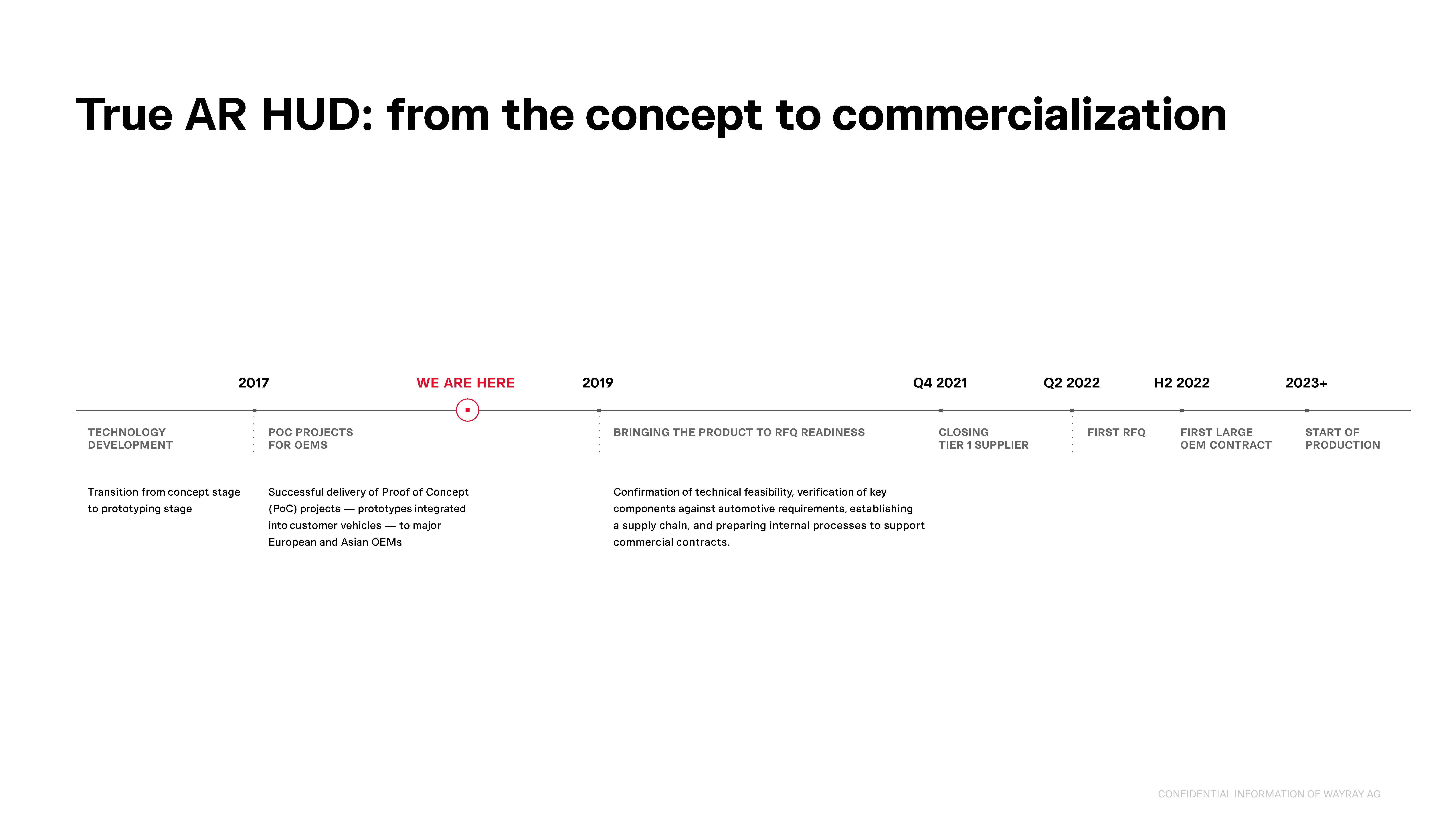
I loved the way the company presents its plans and its milestones to date in a really simple road map (pun intended). The company draws a clear picture of where it is and what it is trying to do.
I would have a lot of questions about this timeline (a Q2 2022 RFQ to production in 2023 doesn’t seem realistic in my experience), but I do appreciate the clarity and the defined goals the company has set.
One of the deepest moats I’ve seen in a while
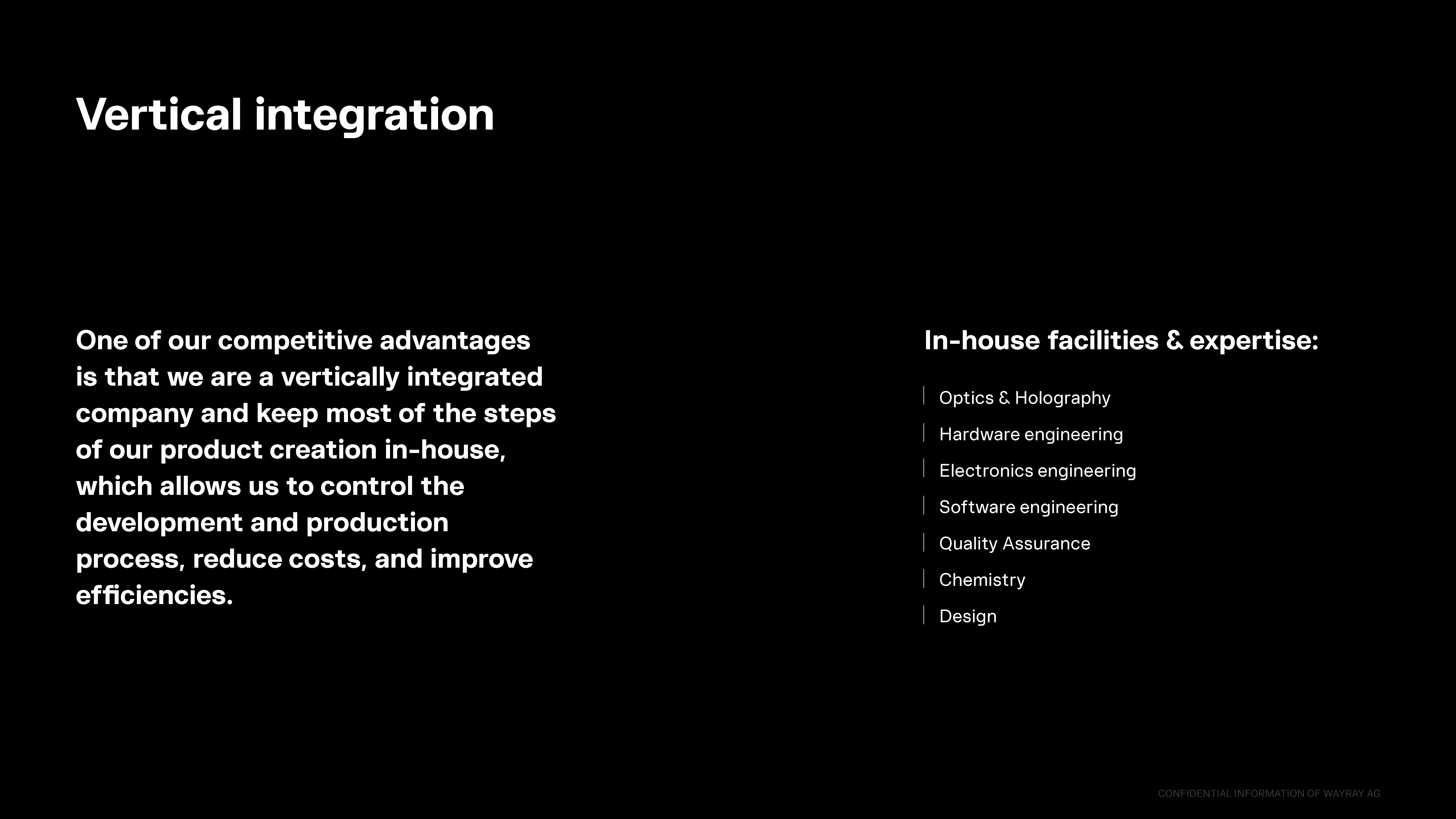
I often recommend young companies do only what is absolutely core to their business and outsource or use platforms for everything else. WayRay takes a different approach — it has in-house personnel for every aspect of its product development and manufacturing process.
The company specifically lists Optics and Holography, Hardware, Software and Electronics Engineering, Quality Assurance, Design and Chemistry. For some hardware companies, I wouldn’t have expected anything else, but in this case, it’s helpful to spell out that WayRay is taking quite a broad approach. Both here, and elsewhere in the deck, it becomes unwaveringly clear that the company has a real interest in, and penchant for, research and development.
Notably, the company doesn’t say if it has an army of IP lawyers making sure that its assets are protected. In fact, the word “patent” doesn’t appear anywhere in the pitch deck, which feels like an oversight.
Nonetheless, the company says: “The underlying intellectual property of our deep tech innovations is well-protected and hard to reproduce.” As an investor, I’d have loved to hear a bit more about how many patents the company is generating, in which parts of the world and how many patents have been approved.
Painting a picture of a very different world
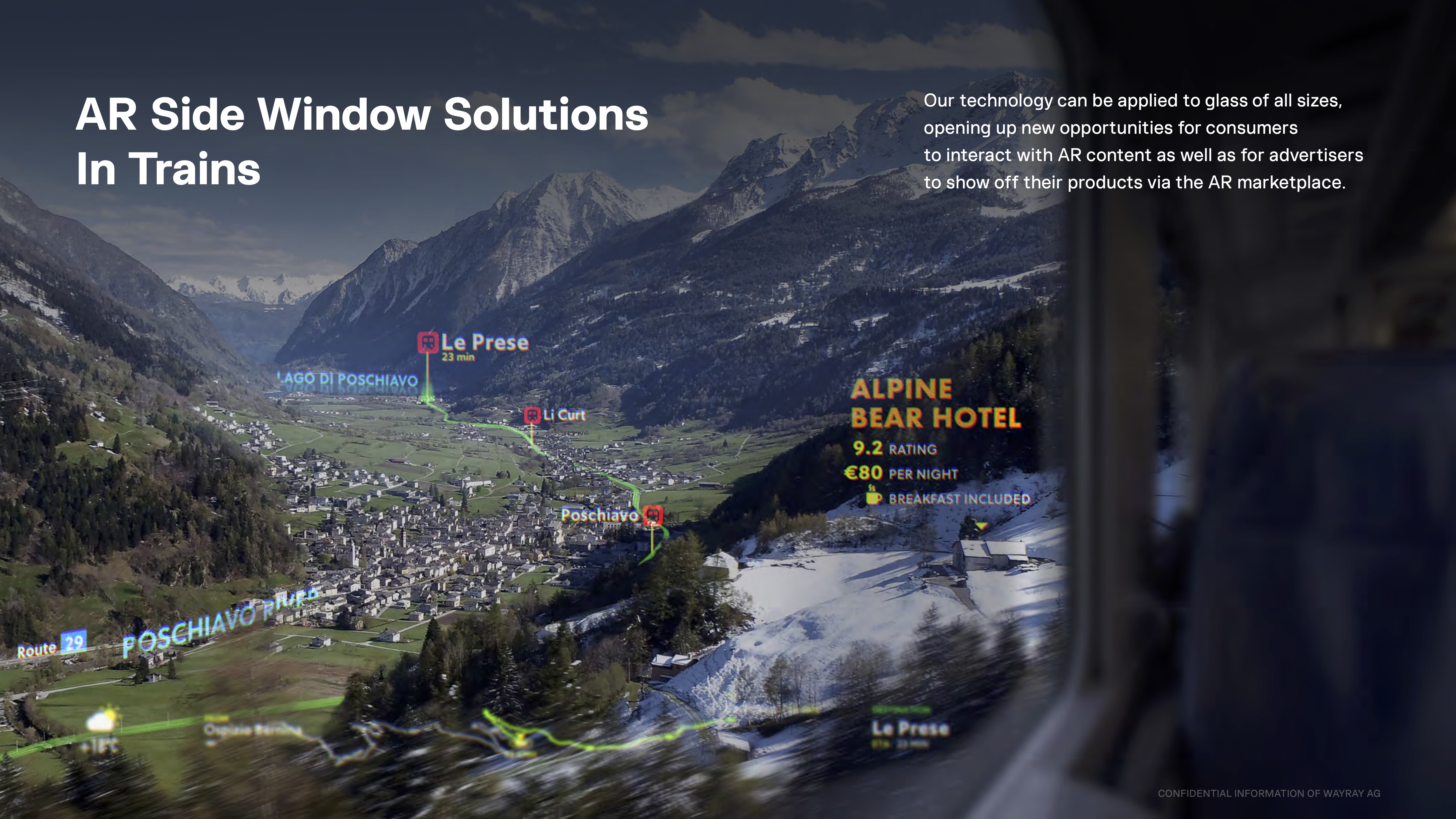
Being a founder is a lonely, wild journey into a future that you can see clearly but doesn’t exist yet. Storytelling is an important part of turning that story into reality, and WayRay does a great job at showing off the world it wants to live in.
This deck has a number of slides showing potential use cases — such as the augmented reality train window mockup above — like tourist destinations with overlays of roads and towns you might be seeing that add information. Is it necessary? Who knows. But it’s so cool that it makes me excited to imagine what it might be like to live in this world.
As a founder, if you’re able to inspire daydreams of the world you’re describing, you’re doing an incredible job. I wouldn’t be at all surprised if these visions — beautifully rendered and shown off throughout the pitch deck — are some great opportunities for that to happen.
In the rest of this teardown, we’ll look at three things WayRay could have improved or done differently, along with its full, 75-slide, unedited, unabridged pitch deck.
Three things that could be improved
Ho boy! OK, so let’s get this out of the way: 75 slides is way, way, way, way too many slides.
What’s worse, some of these slides make me wonder who they are for. It seems as if whoever put these slides together was really excited by the technology (and that’s wonderful), but then they shout about some of the wrong things from the rooftops, which throws the pitch off the track, somehow.
It makes me wonder if I’m missing something; as if this deck wasn’t originally designed to be a fundraising deck but an annual report or something similar. Still, the team I spoke to insisted that this was the fundraising deck WayRay used.
Nonetheless, here are the top three lessons we can learn from this deck.
A deck is not a sales pitch
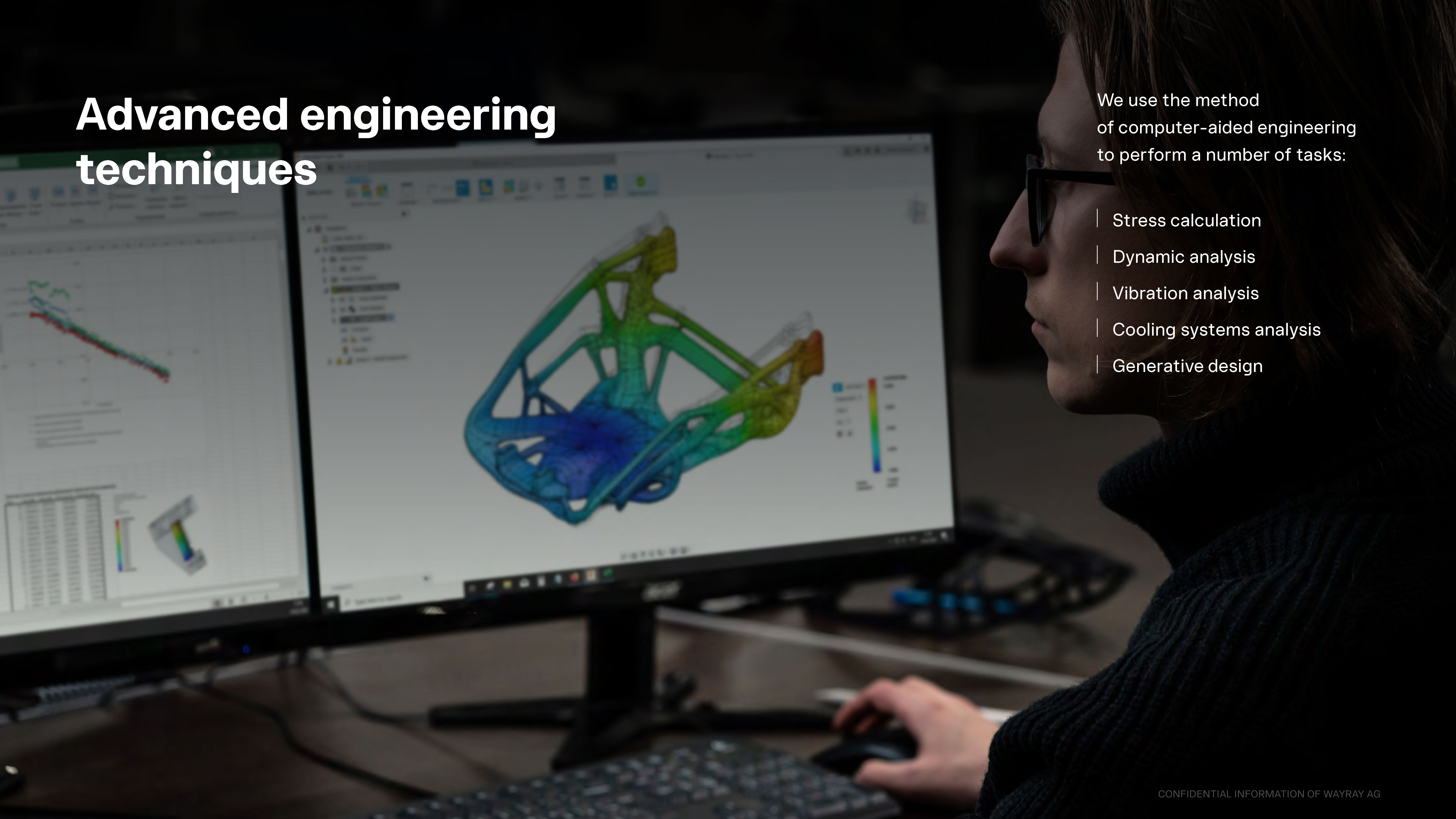
I don’t know who this pitch deck is for, but I’ll tell you one thing: This slide (and many more like it) makes me wonder if the people who put the deck together really knew who they were trying to impress.
I’ve spent a bunch of time helping early-stage hardware startups build the first versions of their products, and everything that WayRay describes on this slide is 100% standard operating procedure. “We use the method of computer-aided engineering” — well, I’d bloody well hope so, because nobody would dream of building this type of product in any other way.
And then to list that they use CAD tools for “stress calculation, dynamic analysis, vibration analysis, cooling systems analysis and generative design” — why, yes, of course you do. These are standard features of high-end product design packages and no automotive manufacturer would let you anywhere near one of their cars if you hadn’t gone through these steps.
Again, it makes me wonder just who the company is trying to convince.
From the 41st slide onward, the company lists the WayRay Overview, which, as far as I can tell, is just a list of its different business units and some of the roles that they play. Slide 46 just says, “Chemistry — Glass Lamination, Technical Engineering, Research,” and I’m finding myself wondering what part of the story this is supposed to tell.
Slide 48 says “Electronics Engineering,” and then “FPGA Design, Analog and Mixed-Signal Design, Power Supply, Systems Design Research, PCB Assembly,” all of which are completely normal roles for electronics engineering. If you put this slide in front of someone who knows what EE entails, they’ll just be confused.
Yes, you’ve done the equivalent of describing a teaching job as “impart knowledge and inspire kids.” If you put this slide in front of someone who doesn’t know what EE is, then it might potentially be impressive. But I just don’t fathom why this is a good use of time. In a world where you typically get 20 to 30 minutes for a first meeting, a 75-slide deck gives you 0.4 seconds per slide.
Why are we trying to explain — at an unhelpful level — what the graphic design team does?
Milestones that aren’t milestones
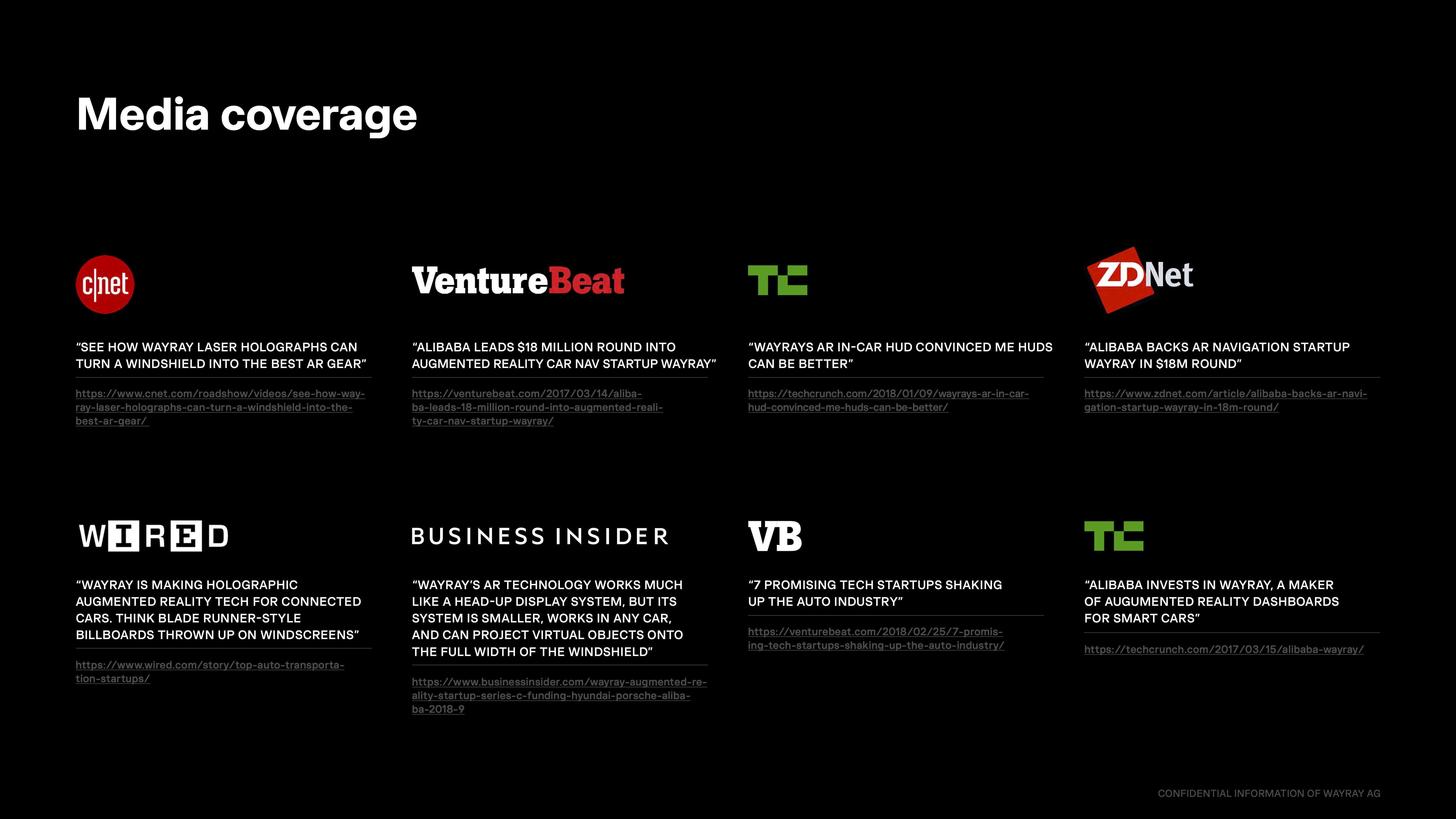
WayRay spends five whole slides talking about the awards it has won, that it has been to the Consumer Electronics Show three times and that it has some press coverage. This makes me jittery because going to a trade show is not something to brag about — you can just pay a lot of money and get yourself a booth at CES.
The awards might have been impressive, but as someone who used to cover the automotive industry, I’m unimpressed. The awards the company highlights are the Top Ten Automotive Startups, 2017, from the LA Auto Show, and The Startup Autobahn People’s Choice Award 2018. Well done, you won a couple of awards, but for people who know how award ceremonies work, neither of these awards are particularly worth boasting about.
Then there’s the press coverage. It’s not impressive that the company was covered by ZDNet (“Alibaba backs AR navigation startup”) or in our own reporting “Alibaba invests in WayRay”). It’s our job to keep an eye on the industry and covering a funding round is our bread and butter.
This set of slides left me scratching my head. It’s just confusing, and if this deck had come across my desk as an investor, I would have opened it up in a PDF viewer and deleted all the slides that didn’t contain meaningful information.
I tried, and you can reduce this deck to about 29 slides or so without losing any important information. Combine some of the slides and you end up with a crisp 20-slide deck.
Way too much technical detail
The pitch deck is not the final salvo that will get you investment; it is the beginning of a conversation. The best pitch decks have a maximum of 20 slides worth of information that draws a compelling picture of why a company is a good investment. From there, it’s possible to have any number of side decks or appendices.
That’s completely OK. Different investors will want to do a deep dive on the financials, the technology, the market, the marketing strategy, the patent portfolio or whatever else. In short, everyone cares about slightly different things. The goal of the pitch deck, then, is to tell a great story that draws everybody in and creates a starting point for discussion.
At the end of a pitching process, you may end up with 75 slides, but the core deck should have 15 to 20. From there, you may have a 10-slide product analysis and road map; a five-slide patent strategy presentation; seven or eight slides on your go-to-market strategy with details on customer acquisition strategies and so on.
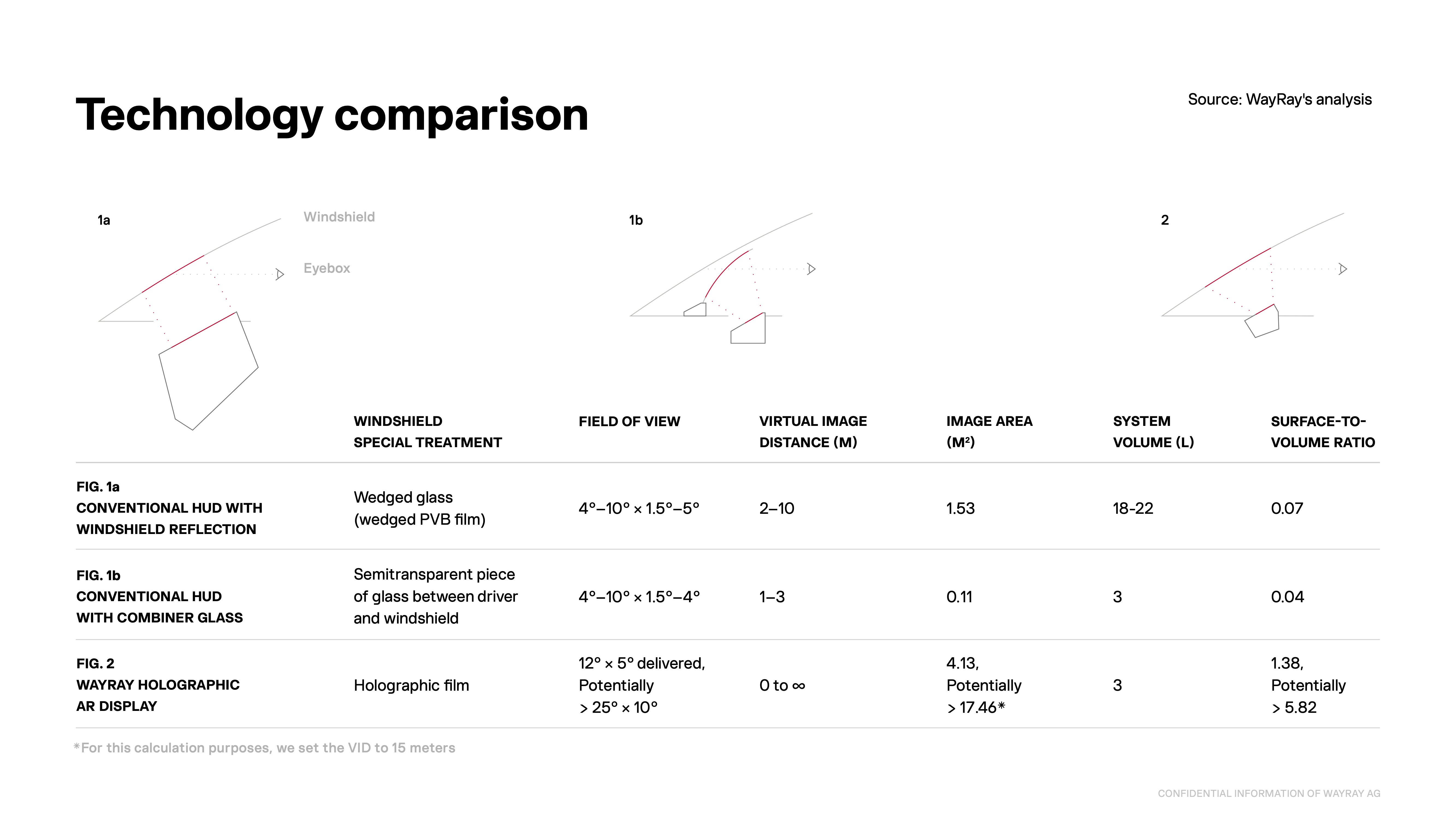
Take Slide 19 of WayRay’s pitch deck, for example, and ask yourself this question: Would an investor choose to invest based on whether the field of view was 1.5 or 1.6 degrees? I’d hazard that half of the information on this slide doesn’t mean anything to anybody. It’s simply too detailed, and it just isn’t interesting enough.
Now, if you’re talking specifically to a product manager of a car who needs to know the exact specifications to ascertain whether this product might be a good addition to the 2028 Honda Accord they are trying to design, sure. The problem is that this is a pitch deck, and we are so far in the weeds that we’re at risk of being exposed to a radioactive frog.
Throughout this deck, I kept getting surprised by the level of detail being presented. Some slides are essentially meaningless — for example, slides 41 to 61 could be summarized into two or three slides, but they could just as easily be omitted altogether. The investors don’t need to know that you have your own testing labs, precision measuring equipment and CNC machines.
It seems like a strange detail to surface to potential investors. The right investors aren’t going to be impressed by whether you own a Swiss-type lathe.
Other slides have way too much detail, like going into the specifications of the company’s holographic and augmented reality tech. Don’t get me wrong, I love geeking out about this as much as the next guy, but showing investors a 30,000-foot view is helpful. It shows that the founders understand which information is important to surface at a board level and which information is irrelevant.
To really nail home the point: I couldn’t care less if the field of view of the company’s AR glass is 1.5 degrees or 2 degrees. What would have been great was if the head of R&D at Porsche was quoted in the deck as saying, “Oh my gosh, we’ve been trying to develop this tech ourselves for 20 years, and we can’t believe WayRay figured it out. We want to put this in every car we ship from 2028 onward, ideally earlier.”
Would you get that exact quote? Of course not, but that’s the vibe we are going for here.
Finally, Slide 65 and the ones immediately following it felt a little off. It’s essentially a brainstorm of all the things that this technology could potentially be used for. That’s cool, but I’m left wondering if this smacks of a lack of focus and desperation.
A company raising $80 million doesn’t need to dream pipe dreams of what could happen — it should be talking about the one or two beachhead markets it wants to focus on, and then perhaps drawing in broad strokes what the plan is for entering other markets. Automotive is one; tell me the other. Don’t have a 28-item brainstorm of “Our tech could be used in … “
It comes across as really unfocused, as if the product team doesn’t really know what it is doing.
Look, they raised at a $500 million valuation
Now that I’ve safely climbed off my high horse, please take all of the above with a couple of jugs of salt. I wasn’t in the pitch meetings or in the deal-flow meetings, or in on the due diligence process. I don’t know what the company got pushback on. I don’t know what the investors saw in this company. And, honestly, I think this deck isn’t very good at all for the reasons described above.
It’s also missing a better overview of what the status of the tech is. There’s no video demo of it in action; there’s no hint at which letters of intent have been signed with car manufacturers. There could have been a slide saying that every BMW will have this tech in the next five years, and it would change everything.
But there was nothing of the sort, and the deck felt really defensive as a result. It feels like a deck that was designed and developed by a committee of too many voices, and that’s not encouraging for any startup.
But, as I have mentioned in previous pitch deck teardowns, it really just doesn’t matter. Any company that can raise an $80 million round, per definition, had a great fundraising deck, and it doesn’t matter what I think of it.
I can’t wait to see where WayRay goes next. Given that it’s been a couple of years since its last fundraising round, I wouldn’t be surprised if it is about to announce another any day now. And, the tech looks cool enough that I’m looking forward to being able to buy a car that has the technology built in.
The full pitch deck
If you want your own pitch deck teardown featured on TC+, here’s more information. Also, check out all our Pitch Deck Teardowns and other pitching advice.































Comment